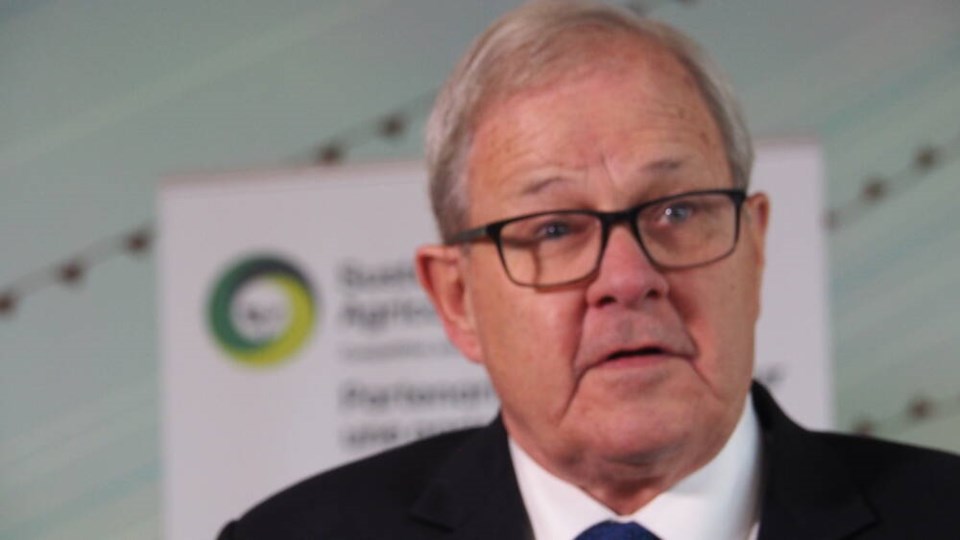WESTERN PRODUCER — The French poet, novelist and playwright Victor Hugo is the first person known to use the term “loose cannon” in print.
He was referring to an actual loose cannon that, improperly lashed down, rolled out of control, damaged the ship, and prevented his protagonist, the Marquis de Lantenac, from landing ashore in Britanny to lead a rebellion.
These days the literal loose cannon of yore has been displaced by the figurative loose cannon — the unpredictable and uncontrolled individual who can create chaos wherever they go.
Canada now has a loose cannon of epic proportions next door. Donald Trump is, to stretch the metaphor just a bit further, not a “crack eight-pounder” found on the deck of an early sailing ship of the Royal Navy. He’s more like one of Saddam Hussein’s super guns that were designed to hurl projectiles the size of a small car as far as 750 kilometres.
That’s to say he’s capable of doing a significant amount of damage through his random actions and out-sized presence.
As you’ll read in our main story this week, the unpredictability is going to be hard for Canada and the world to manage; unpredictability that will inevitably hurt the agricultural sector, should Trump follow through on his threats.
The headline grabber was a 25 per cent tariff on all Canadian and Mexican products, effective Jan. 20, 2025, Trump’s inauguration day. It certainly was a threat that got everyone’s attention on this side of the border. But how likely is it to be implemented?
At first glance, you’d think there wouldn’t be a chance.
It’s not like Canadian or Mexican producers would pay for these tariffs. That bill would be due from U.S. consumers, and a long list of things they buy every day would suddenly get more expensive. Hardly the desire of an inflation-fighting president.
And it would hit the U.S. business community hard too. The global economy is tightly interwoven these days, and those businesses frequently rely on imported products as inputs. Their costs would likewise rise.
It would also open the U.S. to countervailing tariffs under the CUSMA trade agreement, which could catch those businesses in an unpleasant vise as they’re squeezed from both sides and their products become more expensive to consumers abroad.
But it’s also fair to say that Trump has proven himself willing to double down on policies that don’t always follow logic, lending credibility to the threat.
No one is sure how this will play out, and that uncertainty makes it hard to plan. One thing is sure: there will be some unexpected twists and turns along the way.
Will Trump have enough support in his own party to move forward? Will calmer heads prevail? Will Canada and Mexico be able to work together? Or will the U.S. successfully play the two nations off against each other, as Trump did in the last round of CUSMA negotiations?
In no small part, the chaos seems to be part of Trump’s game plan. A confused opponent will be more readily defeated, after all. And perhaps that’s the most important lesson we should learn.
If we respond the way Trump is hoping we do, we’ll be running around with our hair on fire, unable to mount a reasoned and rationale defence of our own interests. But if we keep our powder dry, and make sure our own cannons are lashed down on deck, we just might weather this storm.
Our strategy will need to encompass several key points. We should mount a charm offensive to the south, where we’re seen to be addressing issues our U.S. neighbours raise. We should lean into the trade machinery and quickly use any CUSMA dispute resolution mechanisms at our disposal.
A thornier question is who our allies will be in this fight. The Mexican government, on paper, should be an ally. But we also have the bitter experience of the first Trump presidency, where they engaged in bipartisan negotiations. That resulted in Canada being presented with a ‘take it or leave it’ deal and little recourse.
One thing is certain. As one observer in our main article put it, we can’t look desperate, or we’ll spend the next four years on the run.
Related Coverage
FEATURE: Canadian trade stuck predicting the unpredictable
Former negotiator urges calm on tariffs
Pork sector hopes Manitoba trade office will help address U.S. protectionism
Manitoba to dig deeper trade foothold in Washington
Is Canada playing the right game on trade?
FEATURE: Agriculture sectors look for footing after Trump tariff threat
About the author




